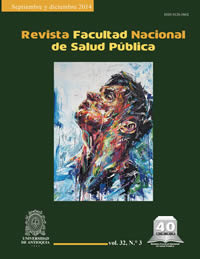Auditorías viales e intervenciones para prevenir atropellamientos, Cuernavaca, México, 2010
DOI:
https://doi.org/10.17533/udea.rfnsp.15765Palabras clave:
prevención, lesiones, seguridad vial, MéxicoResumen
Los atropellamientos son un problema de Salud Pública en México. Representan más del 40% de las muertes reportadas como lesiones causadas por el tránsito (LCT). En zonas urbanas representan hasta el 60% de las LCT. Objetivo: caracterizar y analizar algunas zonas donde se concentraban tanto las muertes como los lesionados por atropellamiento en Cuernavaca, México. Metodología: desde un estudio descriptivo-retrospectivo se planearon y ejecutaron auditorías viales sobre las intersecciones que habían representado mayor riesgo de lesiones y muertes en peatones. En cada lugar se evaluó el aforo peatonal, vehicular, los ciclos semafóricos, las condiciones del medio ambiente físico y se tomaron archivos fotográficos. Resultados: se observó deficiencia de elementos del medio ambiente físico: señalamientos desgastados sobre y al costado de la vía, mala visibilidad por ramas de árboles, vehículos estacionados indebidamente, paradas no autorizadas de transporte público, no uso de puentes peatonales y ciclos semafóricos deficientes. Conclusión: las auditorías viales son herramientas procedentes y empleadas en la ingeniería del tránsito, poco usadas por los salubristas como técnicas para prevenir LCT, en especial atropellamientos. Permiten diseñar e implementar medidas de prevención primaria para disminuir los riesgos de lesión en los usuarios más vulnerables de la vía pública: los peatones.
Descargas
Citas
(1). Organización Panamericana de la Salud. Día Mundial de la Salud, 2004. La seguridad vial no es accidental. [Acceso en Internet julio de 2010]. Disponible en: http://www.paho.org/spanish/DD/PIN/whd04 [Consultado en julio 2010].
(2). Híjar M., Vazquez-Vela, Arreola-Rissa C. Pedestrian traffic injuries in México. Inj Control Saf Promot 2003; 10 (3):37-43. DOI: https://doi.org/10.1076/icsp.10.1.37.14108
(3). Ayuntamiento de Cuernavaca 2006-2009. [Internet] [Acceso el 20 de enero de 2010]. Disponible en: http://www.cuernavaca.gob.mx.
(4). Instituto Nacional de Geografía y Estadística (INEGI) y Secretaría de Salud Federal. Registros de Mortalidad de lesiones de causa externa y atropellamientos de México, 1998-2007. México: Instituto Nacional de Salud Pública de México; 2008.
(5). Barss P, Smith G, Baker S, Mohan D. Injury Prevention: An International Perspective. New York: Oxford University Pres; 1998.
(6). Morency P, Cloutier M. From targeted ‘‘black spots’’ to area-wide pedestrian safety. Inj Prev 2006;12:360-364. DOI: https://doi.org/10.1136/ip.2006.013326
(7). Díaz J. Auditorías en Seguridad Vial, experiencias en Europa. [Internet] Madrid: Instituto Vial Iberoamericano (IVIA) [Acceso el 20 de septiembre de 2011]. Disponible en http://www.institutoivia.com/cisev-ponencias/medicion_gestion_gs/Jacobo_Diaz.pdf.
(8). Cal y Mayor R, Cárdenas J. Ingeniería del tránsito: Fundamentos y aplicaciones. 8ª ed. México: Alfa Omega Editores; 2008.
(9). Gobierno de Morelos. Escuadrón de Rescate Emergencias y Urgencias Médicas de Morelos. Registros de atención pre hospitalaria por atropellamientos, 2008-2009. Morelos, 2010.
(10). Ayuntamiento de Cuernavaca. Secretaría de Protección y Auxilio Ciudadano. Dirección de Bomberos de Cuernavaca. Registros de atención pre hospitalaria por atropellamientos 2008-2009. Cuernavaca: La Secretaría; 2010.
(11). Cruz Roja Mexicana. Delegación Morelos. Registros de atención pre hospitalaria por atropellamientos 2008-2009. Cuernavaca: Cruz Roja Mexicana; 2010.
(12). Esri.com [internet] New York: Esri [Acceso 12 dejunio de 2011]. Disponible en: http://www.esri.com/software/arcgis/index.html.
(13). Franco C. Auditoría en seguridad vial. Ambiente seguro: Intervenciones para prevención de atropellamientos (ASIPA): Estudios viales. Cuernavaca: Instituto Nacional de Salud Pública de México, 2010:38.
(14). Google Maps. Mapa de Cuernavaca; México. [Internet] [Acceso en Internet junio de 2011]. Disponible en: http://maps.google.com.mx/maps/.
(15). Peek-Asa C, Zwerling C. Role of environmental interventions in injury control and prevention. Epidemiol Rev. 2003;25:77-89.} DOI: https://doi.org/10.1093/epirev/mxg006
(16). Retting RA, Ferguson S, McCartt. A review of evidence-based traffic engineering measures designed to reduce pedestrian-motor vehicle crashes. Am J Public Health. 2003;93:1456-1463. DOI: https://doi.org/10.2105/AJPH.93.9.1456
(17). Rodríguez JM, Híjar M, Campuzano JC, Bangdiwala S, Villaveces A. Methodological proposal for implementing an intervention to prevent pedestrian injuries, a multidisciplinary approach: the case of Cuernavaca, Morelos, Mexico. Inj Prev 2013. DOI: 10.1136/injuryprev-2013-040776. DOI: https://doi.org/10.1136/injuryprev-2013-040776
(18). Hidalgo E, Híjar M, Campuzano J, Rodríguez J, Chías L, Reséndiz H et al. Motivos de uso y no uso de puentes peatonales y atropellamiento en la ciudad de México, 2008. Salud Pub Mex. 2010;52(6):502-510. DOI: https://doi.org/10.1590/S0036-36342010000600004
(19). World Health Organization. World report on road traffic injury prevention. [Internet] Washington: WHO [Acceso en Internet Octubre de 2011]. Disponible en: http://whqlibdoc.who.int/paho/2004/927531599X.pdf.
(20). Concha-Eastman A, Clavel-Arcas C. Lesiones de causa externa: avances en la información, el análisis y la atención de casos; Rev. Panam Salud Pública, 2008;24(6):371-374. DOI: https://doi.org/10.1590/S1020-49892008001200001
(21). Zegeer C, Stewart R, Huang H, Lagerwey P, Feaganes J, Campbell B. Safety effects of marked versus unmarked crosswalks at uncontrolled locations: Final report and recommended guidelines. Office of safety research and development. Federal Highway Administration, 2005.
(22). Elvik R, Vaa T. El manual de las medidas de seguridad vial. Madrid: Elsevier Ltda; 2006.
(23). Hydén C, Várhelyi A. The effects on safety, time consumption and environment of large scale use of roundabouts in an urban area: a case study. Accid Anal Prev. 2000;32:11-23. DOI: https://doi.org/10.1016/S0001-4575(99)00044-5
(24). Easa S, Cheng, J. Reliability Analysis of Minimum Pedestrian Green Interval for Traffic Signals. J Transp Eng. 2013;139:651-659. DOI: https://doi.org/10.1061/(ASCE)TE.1943-5436.0000549
(25). Rodríguez JM, Campuzano JC. Medidas de prevención primaria para controlar lesiones y muertes en peatones y fomentar la seguridad vial. Rev Salud Pública 2010;12:497-509.
Descargas
Publicado
Cómo citar
Número
Sección
Licencia
Derechos de autor 2021 Jorge M. Rodríguez H., Martha Híjar M., Andrés Villaveces I.

Esta obra está bajo una licencia internacional Creative Commons Atribución-NoComercial-CompartirIgual 4.0.
El autor o los autores conserva(n) los derechos morales y cede(n) los derechos patrimoniales que corresponderán a la Universidad de Antioquia, para publicarlo, distribuir copias electrónicas, incluirlas en servicios de indización, directorios o bases de datos nacionales e internacionales en Acceso Abierto, bajo la licencia Creative Commons Atribución-No Comercial-Compartir Igual 4.0 Internacional Comercial (CC BY-NC-SA) la cual permite a otros distribuir, remezclar, retocar y crear a partir de la obra de modo no comercial, siempre y cuando se dé crédito respectivo y licencien las nuevas creaciones bajo las mismas condiciones.












 --
-- --
-- --
--